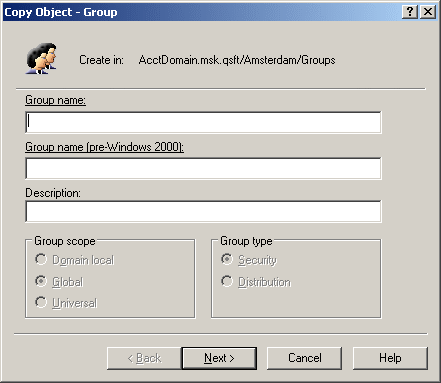To find groups in which a user is a member
- In the console tree, locate and select the folder that contains the user account.
- In the details pane, right-click the user account, and then click Properties.
- Click the Member Of tab.
To find groups in which a user is a member
To create a copy of a group, right-click the group, click Copy, and follow the instructions in the wizard. The first step of the wizard looks as shown in the following figure.
Figure 11: Copying a group

The copy contains the same permission settings as the original group. The Copy Object ‑ Group wizard allows you to modify the membership list of the new group.
To copy a group
|
|
NOTE:
|
To modify group properties, right-click the group and click Properties. You can make changes to group properties using the Properties dialog box, shown in the following figure.
Figure 12: Modifying group properties

In the Properties dialog box, some property labels may be displayed as hyperlinks. The hyperlink indicates that Active Roles enforces certain policy restrictions on the property. To examine policy details, click the hyperlink: the policy information is displayed (see Getting policy-related information earlier in this document).
The policy information is also displayed whenever you supply a property value that violates a policy restriction. Property changes cannot be applied until you enter an acceptable value.
You can use the Properties dialog box to view or modify any property of the group: go to the Object tab and click Advanced Properties. In the Advanced Properties window you can manage all properties, including those that cannot be accessed via the Properties dialog box itself.
You can also display the Advanced Properties window as follows: right-click the group and select All Tasks | Advanced Properties.
|
|
NOTE: In the console, you can select multiple groups, right-click the selection, click Properties, and then modify properties of all the selected groups collectively via the Properties dialog box. |
© 2025 One Identity LLC. ALL RIGHTS RESERVED. Términos de uso Privacidad Cookie Preference Center